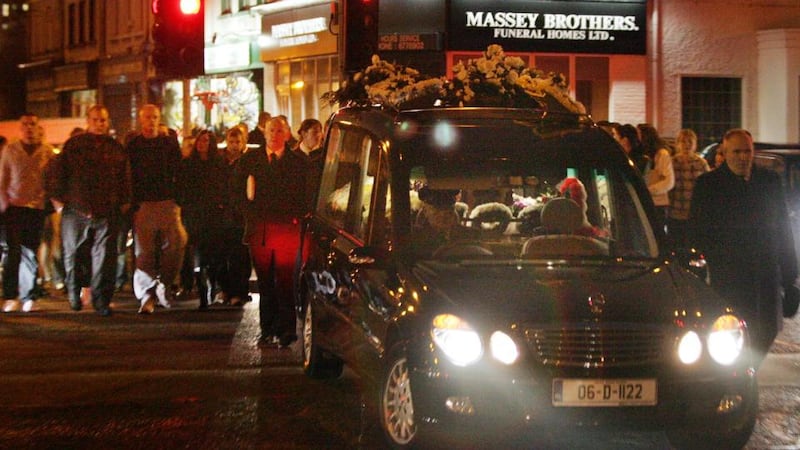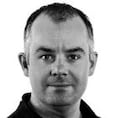When Steve Collins stepped into the sunshine surrounded by his family outside the Court of Criminal Justice in Dublin in July he looked relieved but broken. Wayne Dundon and Nathan Killeen had just been sentenced to life for killing his only son, Roy, five years earlier.
The Limerick men, aged 36 and 24, had acted in vengeance against the Collins family, whose evidence had been instrumental in securing an earlier conviction against Dundon for shooting Collins’s stepson Ryan Lee in 2004. Lee had refused to allow the Limerick criminal’s 14-year-old sister into a family-owned pub. He was shot minutes later, after Dundon had threatened him with death.
A campaign of terror followed during which the family's pubs were set alight, eventually forcing their closure. The intimidation culminated in the shooting dead of Roy Collins in 2009, after which the family fled Limerick.

But when Dundon was convicted of murder, three months ago, Steve Collins wondered aloud if he could maybe come back to Ireland, give it another go in Limerick and rebuild his life.
Dundon can make no such plans. With the average life sentence now lasting 18 years, his status as perhaps the most violent criminal in the history of Irish gangland will likely keep him in prison past his 60th birthday.
The fortunes of gangland across the State have mirrored those of Dundon and the men he once controlled. The money and power have ebbed away since the booming economy peaked in 2008. Many of those who led the biggest gangs in the country in gangland’s glory days are dead or in prison.
But after rapid declines in drug and gun crime since 2008 there are signs that drug gangs are on the way back. As confidence and money begin to stimulate more consumer activity on the high street, “green shoots of recovery” are also appearing in the drug underworld.
Gang crime peaked in 2008 but then crashed in parallel with the rest of the economy. Recorded drug crime jumped by 65 per cent from 2004, to a peak of 23,404 offences in 2008, and then fell 34 per cent between 2008 and 2013, when 15,384 drug crimes were recorded.
The other pillar on which the underworld is built, gun crime, increased more slowly, to a peak in 2007-08. Its subsequent decline was pronounced. The offence of discharging a firearm increased by 55 per cent between 2003 and 2008, then fell by half. Possession-of-a-firearm offences followed a similar pattern.
But the most recent crime statistics, for the 12 months to the end of June this year, reveal that drug crime is on the increase again. The rise – of just 2 per cent – looks modest but is significant in that it follows five years of decline.
There has also been an increase in some categories of gun crime. The offence of discharging a firearm reached a low in 2012 but increased last year by 12 per cent. The 12 months to the end of June 2014 revealed increases of about 6 per cent. Other categories of gun crime have fallen in the same period, however. Possession-of-a-firearm offences continue to fall:by 22 per cent last year and by almost 29 per cent in the 12 months to the end of June this year.
Ian O’Donnell, professor of criminology at University College Dublin, says the contraction in the drug trade during the recession was down to the declining disposable incomes of recreational drug users. Likewise, the armed attacks that had become part of the the drug trade became less common.
“You could reasonably speculate that people just weren’t willing to take the risks in an environment where the financial rewards were now much lower,” he says of gun offences, which carry hefty jail terms on conviction and reprisals for the gunmen.
But Garda sources say that if disposable incomes continue to recover, the demand for drugs will rise and the gun law that runs the drug trade will also reassert itself. It won’t be quite the same as before, however. The recession has changed the drug landscape.
“One of the things we notice is the much more significant international dimension to it now,” says one Garda source. “The gangs are still bringing drugs in from Spain, but others are more inclined to go to the source now: to deal directly with [cartels in] South America for cocaine and places like Pakistan and Afghanistan for heroin.”
Another officer believes the depression in the drug market since 2008 has forced gangs to innovate. “We saw a few years ago that, when tiger kidnappings started, everyone wanted to get in on the act, and one crowd just copied another,” he says. “And you might have an element of that here, too: one crowd starts getting [drugs] directly from South America, and the others decide they need to do that, too.”
The officer adds that, to maintain cash flow and service debts to international cartels, some criminals reduced the price of their drugs, giving rise to “price wars” in recent years. “Some of them have turned to getting the drugs directly from source, where it’s cheaper and purer, and so you get your margins back up. The intelligence is suggesting that’s what’s happening.”
He adds that an Irish-led gang in southern Spain is the main source of drugs flowing into Ireland. It is trying to shape the trade by deciding who is allowed entry into major domestic drug dealing.
Another source said although Irish gangs had already been moving their assets abroad before the drug trade peaked, the lower returns from dealing in recent years meant many redoubled their efforts to put their wealth beyond the reach of the Criminal Assets Bureau.
“They are going to very elaborate lengths now to create financial and investment vehicles abroad, to get the money offside. And they’re taking much more advice from professionals to do that.
“Certainly before now we would have often seen people who felt by buying a house here in a relative’s name they were hiding it. But now they are creating company structures abroad and doing a lot of research and planning to protect what they have.”
A Dublin-based Garda says that even though seizures of smuggled cigarettes declined during the recession, the trade is not thought to have contracted.
“Customs tell us that game is at least the same size as it was before – and probably much bigger. But some of the drug gangs have branched into it, and they are putting the same effort into concealing cigarettes as they did with drugs.
Another officer says the armed-robbery landscape is “unrecognisable” compared with 2008. “Tiger kidnappings became popular, but the security protocols are being followed by [post office and bank] staff more often now. We’ve caught a number of the gangs, and the sentences have been huge. That puts these people off.
“So as the money creeps back into drugs, the guys who had been doing cash robberies might see drugs as easier. And then that drives competition and feuding and so on, so it’s always changing. It never settles down, really.”
ALL QUIET?
What happened to the feuding gangs?
Having preoccupied the Garda and media for a cocaine-fuelled decade of excess until the drugs trade peaked, in 2008, the feuding gangs of Dublin and Limerick have been relatively silent of late.
Some of those who drove the feuding are now living abroad, with southern Spain the preferred destination. But most of the key players are either dead or in jail.
In Finglas, in north Dublin, Marlo Hyland led the largest drug and armed-robbery gang in the State. But so prolific had he become that the Garda launched an operation to bring down his empire. Under Operation Oak, Hyland and those around him were subjected to close Garda attention.
In December 2006 his associates shot him dead.
His successor, Eamon Dunne, was killed in a pub in Cabra, in Dublin, in April 2010 but not before 11 people had been murdered by the Finglas-based gang while he was in charge.
The man who took over from Dunne has been warned by gardaí several times that his life is in danger, and he has kept a much lower profile.
In Limerick almost all of the main players in the McCarthy-Dundon gang are in jail, and several key people who belonged to the rival Keane-Collopy gang are either in prison or dead. The Limerick feud killings have stopped.
The Crumlin-Drimnagh feud saw two groups of young men unleash a killing spree that cost 12 lives. One of the gang leaders, Brian Rattigan, is in prison serving life for a stabbing murder. His rival gang leader is in prison awaiting trial.
In Blanchardstown, in west Dublin, the collective referred to by the media as the Westies are almost all dead.
Shane Coates and Stephen Sugg were shot dead in Spain in 2004, at the ages of 21 and 27, and buried in concrete under a warehouse, their bodies not found for almost three years. Bernard Sugg, who was 23, was shot in 2003.
The rivals of Coates and the Suggs, brothers Andrew and Mark Glennon, aged 30 and 32, were shot dead in April 2005. In Coolock, in north Dublin, a number of rival factions have killed key players on each side; others have been jailed.
Similar scenarios have played out in localised feuds in Sheriff Street, in the north inner city, in Darndale and Baldoyle, on the north side, and in Clondalkin, in the west.
Since the murder two years ago of the then leader of the Real IRA in Dublin, Alan Ryan, the extortion-based feud between the dissident republicans and Dublin’s main organised crime gangs has been silent.














